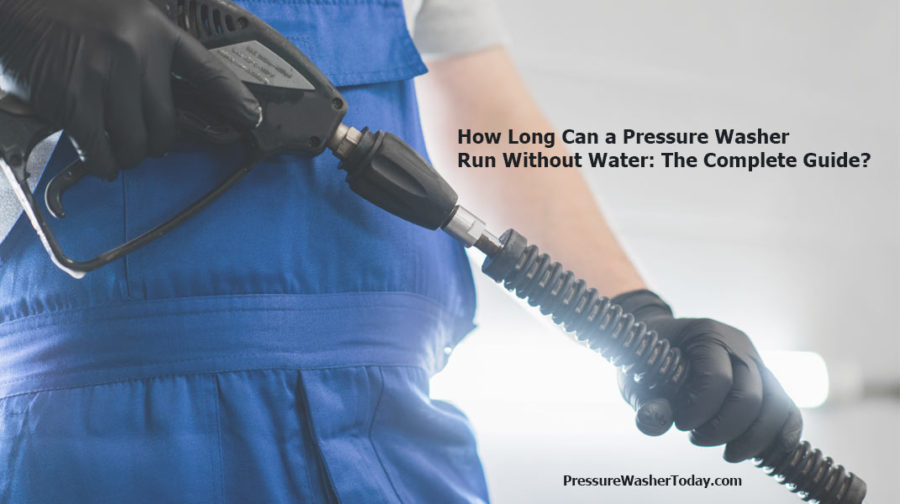When you’re using a pressure washer, you want to make sure that it’s running at its best. That means having enough water flowing through the machine to create the desired effect. But what happens if there’s an issue with the water supply? Can a pressure washer run without water? In this guide, we’ll answer that question and more!
If you’re using a pressure washer, you need to have a consistent water supply. That means that if the water flow is interrupted, the machine can’t run. So, can a pressure washer run without water? No, it can’t. If there’s no water flowing through the machine, it won’t be able to work correctly.
Table of Contents
How Does A Pressure Washer Work?
A pressure washer is a machine that uses high-pressure water to remove dirt, grime, and other debris from surfaces. Pressure washers can be used on a variety of surfaces, including concrete, stone, brick, wood, and metal.
Pressure washers work by using a pump to generate high-pressure water. This high-pressure water is then passed through a hose to a nozzle. The nozzle can be adjusted to create a variety of different spray patterns, depending on the surface being cleaned.
Once you’ve familiarized yourself with the machine and taken all the necessary safety precautions, you’re ready to start pressure washing. Begin by attaching the hose to the machine and plugging it into an outlet. If you’re using a gas-powered pressure washer, fill the tank with fresh gasoline and check the oil level before starting the engine.
Kinds of Engines
There are two main types of engines found in pressure washers: gas and electric. Gas models tend to have more power and can be used for tougher jobs, while electric models are more affordable and better suited for light-duty tasks. If you’re not sure which type of engine is right for you, consult your owner’s manual or with the pressure washer manufacturer.
Gas-powered pressure washers can run for up to four hours on a single tank of gas, while battery-electric models can usually operate for about 20 minutes before needing to be recharged. If you’ll be using your pressure washer for extended periods of time, it’s important to choose a model with a long run time. If you need to use your pressure washer in an area where there is no water flow here is what to do:
What Happens Where there is No Water Flow?
If there is no water flow, the pressure washer will not be able to create the amount of pressure required to do its job properly. This can cause a few problems, including decreased performance and increased wear and tear on the machine. In some cases, it can even damage the pump.
That’s why it’s important to make sure there is always a steady supply of water available when using a pressure washer. If you’re not sure how long your machine can run without water, it’s best to err on the side of caution and shut it off as soon as possible.
As we mentioned, running a pressure washer without water can cause decreased performance and increased wear and tear. In addition, it can also damage the pump.
Pressure washers rely on a steady supply of water to function properly. Without water, the pump can overheat, which can lead to a few problems, including decreased performance, increased wear, and tear, and even damage to the pump.
So, how long can a pressure washer run without water? While it depends on the specific model, most pressure washers can only run for a few minutes without water before they start to experience problems.
How to Use Pressure Washer Without A Tap Water Source
Pressure washers are a fantastic way to clean your home without having to use harsh chemicals. However, they do require a water source to work properly. If you don’t have access to a tap water source, you can still use a pressure washer by following these simple steps.
First, fill a bucket with clean water. Next, place the pressure washer’s intake hose into the bucket of water. Finally, turn on the pressure washer and start cleaning. By following these simple steps, you can easily use a pressure washer without a tap water source.
Safety Precautions
Before using your pressure washer, be sure to read the owner’s manual and familiarize yourself with the machine. Pay close attention to the safety precautions and always wear protective gear, including gloves, goggles, and earplugs. Never point the nozzle at yourself or anyone else, and never operate the machine without proper ventilation.
If you’re using a gas-powered pressure washer, be sure to fill the tank with fresh gasoline before each use. Old or contaminated fuel can damage the engine and lead to costly repairs. Also, be sure to check the oil level and change the oil regularly according to the manufacturer’s recommendations.
Electric pressure washers are generally easier to maintain than gas models, but you still need to take care of the machine. Be sure to keep the power cord and hose free of kinks and knots, and always unplug the machine before performing any maintenance tasks. If you notice any damage to the cord or hose, replace them immediately.
Final Word
If you’re having issues with your water supply, the best thing to do is to contact a professional. They can help you troubleshoot the issue and get your pressure washer running again in no time! Thanks for reading and we hope this guide was helpful.

